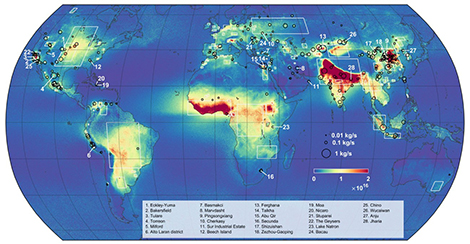Global S&T Development Trend Analysis Platform of Resources and Environment
| Pollution : New ammonia emission sources detected from space | |
| admin | |
| 2018-12-05 | |
| 发布年 | 2018 |
| 语种 | 英语 |
| 国家 | 法国 |
| 领域 | 地球科学 |
| 正文(英文) | Researchers from the CNRS1 and the Université Libre de Bruxelles (ULB) have prepared the first global map of the distribution of atmospheric ammonia (NH3) by analyzing measurements taken by satellites between 2008 and 2016. The IASI interferometer developed by the CNES allowed them to catalog more than 200 ammonia sources, two-thirds of which had never been identified before. These sources are essentially sites of intensive livestock production and industrial activity. The team's findings are published in Nature (December 5).
For the last twelve years, the IASI interferometer on board three successive Metop2 satellites have been providing scientists with global data on various atmospheric components, including ammonia. Atmospheric ammonia merits particular attention because it breaks down into fine ammonium salt particles that degrade the quality of the air we breathe. Yet the processes regulating concentrations of this gas are still poorly understood, especially on the local scale.
Using the daily data on ammonia levels recorded by the interferometers over a period spanning nearly ten years, the researchers generated a map of the global atmospheric distribution of ammonia whose resolution is on the order of a square kilometer. By combining their map with satellite imagery, they uncovered and categorized 241 point sources of anthropogenic NH3 emissions83 linked to intensive livestock production and 158 to industrial activityas well as 178 wider emission zones. (See map). In addition to recording new sources not found on current emission inventories, the study has shown that levels of emissions from previously identified sources are greatly underestimated. By observing changes in the data over time, the team was also able to trace developments of the associated human activities, like the startup or shutdown of industrial complexes or the expansion of infrastructures for intensive animal farming. These findings suggest that better management of the impact of ammonia pollution requires a comprehensive review of ammonia emissions, which are much higher than presently suggested by inventories.  © Martin Van Damme and Lieven Clarisse / ULB Map of atmospheric ammonia fluxes based on 9 years of IASI data. It shows 242 hot spots, surrounded by black circles, and 178 wider emission zones, framed by white rectangles.  © Martin Van Damme et Lieven Clarisse / ULB (IASI); © Google / NASA (Landsat) Images of one point source of ammonia emissions in China attributed to the construction of an industrial complex. Bottom: Landsat satellite photographs (20082016) showing the facility's construction. Top: IASI ammonia measurements over the same period. Video on IASI interferometer (in French) Interactive map of atmospheric ammonia emission sources Télécharger le communiqué de presse :  Notes:1 These scientists belong to the LATMOS research laboratory (CNRS / Sorbonne University / Université de Versailles Saint-Quentin-en-Yvelines). Along with eight other labs whose research focuses on the global environment, it is a part of the Institut Pierre Simon Laplace (IPSL). Bibliography:Industrial and agricultural ammonia point sources exposed. Van Damme, M., Clarisse, L., Whitburn, S., Hadji-Lazaro, J., Hurtmans, D., Clerbaux, C., Coheur, P.-F. Nature, December 5, 2018. DOI: 10.1038/s41586-018-0747-1. Contacts: CNRS researcher l Cathy Clerbaux l cathy.clerbaux@latmos.ipsl.fr |
| URL | 查看原文 |
| 来源平台 | Centre national de la recherche scientifique |
| 文献类型 | 新闻 |
| 条目标识符 | http://119.78.100.173/C666/handle/2XK7JSWQ/106933 |
| 专题 | 地球科学 |
| 推荐引用方式 GB/T 7714 | admin. Pollution : New ammonia emission sources detected from space. 2018. |
| 条目包含的文件 | 条目无相关文件。 | |||||
| 个性服务 |
| 推荐该条目 |
| 保存到收藏夹 |
| 查看访问统计 |
| 导出为Endnote文件 |
| 谷歌学术 |
| 谷歌学术中相似的文章 |
| [admin]的文章 |
| 百度学术 |
| 百度学术中相似的文章 |
| [admin]的文章 |
| 必应学术 |
| 必应学术中相似的文章 |
| [admin]的文章 |
| 相关权益政策 |
| 暂无数据 |
| 收藏/分享 |
除非特别说明,本系统中所有内容都受版权保护,并保留所有权利。
修改评论